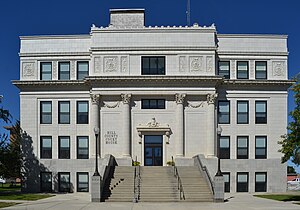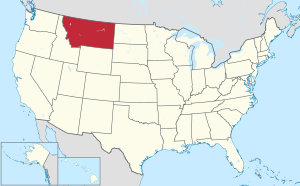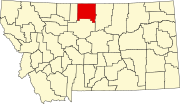Hill County, Montana
Hill County | |
|---|---|
 Hill County Courthouse in Havre | |
 Location within the U.S. state of Montana | |
 Montana's location within the U.S. | |
| Coordinates: 48°38′N 110°07′W / 48.63°N 110.11°W | |
| Country | |
| State | |
| Founded | 1912 |
| Named for | James J. Hill |
| Seat | Havre |
| Largest city | Havre |
| Area | |
• Total | 2,916 sq mi (7,550 km2) |
| • Land | 2,899 sq mi (7,510 km2) |
| • Water | 17 sq mi (40 km2) 0.6% |
| Population (2020) | |
• Total | 16,309 |
• Estimate (2022) | 16,068 |
| • Density | 5.6/sq mi (2.2/km2) |
| Time zone | UTC−7 (Mountain) |
| • Summer (DST) | UTC−6 (MDT) |
| Congressional district | 2nd |
| Website | hillcounty |
| |
Hill County is a county located in the U.S. state of Montana. As of the 2020 census, the population was 16,309.[1] Its county seat is Havre.[2] It lies along the United States border with Canada, abutting Alberta and Saskatchewan.
Part of its territory is within the Rocky Boy Indian Reservation, which is held by the federally recognized Chippewa-Cree Tribe.
History
[edit]The first European-American settlement in the future county area was Fort Assinniboine, garrisoned by the United States Army in 1879. Fifteen of the original 104 structures from the fort are still standing. A portion of the fort was ceded for use as the Indian reservation, which was established in 1916.
The county is named after James J. Hill, president of the Great Northern Railway Company, which built the rail line across Montana as part of the Transcontinental Railroad to the Pacific coast.
Geography
[edit]According to the United States Census Bureau, the county has a total area of 2,916 square miles (7,550 km2), of which 2,899 square miles (7,510 km2) is land and 17 square miles (44 km2) (0.6%) is water.[3]
Hill County is on the "Hi-Line" in north-central Montana. It borders Blaine County to the east, Liberty County to the west, and Canada to the north. Hill County contains Beaver Creek Park, the nation's largest county park.
It is one of the few locations in the United States to have an antipodal point on land, and its community of Rudyard is the only populated such place. The Kerguelen Islands are on the opposite side of the earth from parts of Hill County, while the antipodal points of almost all other places in the United States lie in the Indian Ocean.
Adjacent counties and rural municipalities
[edit]- Liberty County - west
- Chouteau County - south
- Blaine County - east
- County of Forty Mile No. 8, Alberta - northwest
- Cypress County, Alberta - north
- Rural Municipality of Reno No. 51, Saskatchewan - northeast
Major highways
[edit]National protected areas
[edit]Politics
[edit]In presidential elections, Hill County is a swing county. Since 1952, it has voted for the Democratic nominee nine times and the Republican nominee nine times and the nationwide winner from 1992 to 2016.
| Year | Republican | Democratic | Third party(ies) | |||
|---|---|---|---|---|---|---|
| No. | % | No. | % | No. | % | |
| 2024 | 3,871 | 56.89% | 2,634 | 38.71% | 299 | 4.39% |
| 2020 | 3,957 | 55.10% | 2,981 | 41.51% | 244 | 3.40% |
| 2016 | 3,478 | 53.96% | 2,371 | 36.79% | 596 | 9.25% |
| 2012 | 3,164 | 46.36% | 3,403 | 49.86% | 258 | 3.78% |
| 2008 | 2,787 | 42.07% | 3,596 | 54.28% | 242 | 3.65% |
| 2004 | 3,505 | 52.65% | 2,997 | 45.02% | 155 | 2.33% |
| 2000 | 3,392 | 51.72% | 2,760 | 42.09% | 406 | 6.19% |
| 1996 | 2,601 | 36.58% | 3,517 | 49.46% | 993 | 13.96% |
| 1992 | 2,408 | 29.79% | 3,618 | 44.77% | 2,056 | 25.44% |
| 1988 | 3,467 | 44.50% | 4,219 | 54.15% | 105 | 1.35% |
| 1984 | 4,635 | 55.24% | 3,657 | 43.59% | 98 | 1.17% |
| 1980 | 4,448 | 54.99% | 2,875 | 35.54% | 766 | 9.47% |
| 1976 | 3,274 | 45.10% | 3,878 | 53.42% | 108 | 1.49% |
| 1972 | 3,759 | 53.06% | 3,061 | 43.20% | 265 | 3.74% |
| 1968 | 2,970 | 44.53% | 3,386 | 50.77% | 313 | 4.69% |
| 1964 | 2,101 | 31.81% | 4,491 | 68.00% | 12 | 0.18% |
| 1960 | 3,163 | 45.73% | 3,741 | 54.09% | 12 | 0.17% |
| 1956 | 3,415 | 53.24% | 2,999 | 46.76% | 0 | 0.00% |
| 1952 | 3,474 | 55.44% | 2,748 | 43.86% | 44 | 0.70% |
| 1948 | 1,645 | 31.75% | 3,321 | 64.10% | 215 | 4.15% |
| 1944 | 1,646 | 35.25% | 2,986 | 63.95% | 37 | 0.79% |
| 1940 | 1,842 | 32.79% | 3,700 | 65.87% | 75 | 1.34% |
| 1936 | 1,014 | 18.37% | 4,328 | 78.41% | 178 | 3.22% |
| 1932 | 1,589 | 31.44% | 3,257 | 64.44% | 208 | 4.12% |
| 1928 | 2,336 | 53.37% | 2,022 | 46.20% | 19 | 0.43% |
| 1924 | 1,110 | 30.60% | 602 | 16.59% | 1,916 | 52.81% |
| 1920 | 2,220 | 55.44% | 1,388 | 34.67% | 396 | 9.89% |
| 1916 | 1,709 | 31.73% | 3,241 | 60.17% | 436 | 8.10% |
| 1912 | 536 | 26.43% | 624 | 30.77% | 868 | 42.80% |
Demographics
[edit]| Census | Pop. | Note | %± |
|---|---|---|---|
| 1920 | 13,958 | — | |
| 1930 | 13,775 | −1.3% | |
| 1940 | 13,304 | −3.4% | |
| 1950 | 14,285 | 7.4% | |
| 1960 | 18,653 | 30.6% | |
| 1970 | 17,358 | −6.9% | |
| 1980 | 17,985 | 3.6% | |
| 1990 | 17,654 | −1.8% | |
| 2000 | 16,673 | −5.6% | |
| 2010 | 16,096 | −3.5% | |
| 2020 | 16,309 | 1.3% | |
| 2022 (est.) | 16,068 | [6] | −1.5% |
| U.S. Decennial Census[7] 1790–1960,[8] 1900–1990,[9] 1990–2000,[10] 2010–2020[1] | |||
2020 census
[edit]As of the 2020 census, there were 16,309 people living in the county.[citation needed]
2010 census
[edit]As of the 2010 census, there were 16,096 people, 6,275 households, and 4,020 families living in the county. The population density was 5.6 inhabitants per square mile (2.2/km2). There were 7,250 housing units at an average density of 2.5 per square mile (0.97/km2). The racial makeup of the county was 73.9% white, 21.7% American Indian, 0.4% Asian, 0.3% black or African American, 0.3% from other races, and 3.3% from two or more races. Those of Hispanic or Latino origin made up 2.3% of the population. In terms of ancestry, 28.9% were German, 18.5% were Norwegian, 12.7% were Irish, 9.2% were English, and 3.0% were American.
Of the 6,275 households, 32.5% had children under the age of 18 living with them, 46.3% were married couples living together, 11.9% had a female householder with no husband present, 35.9% were non-families, and 29.8% of all households were made up of individuals. The average household size was 2.47 and the average family size was 3.10. The median age was 35.1 years.
The median income for a household in the county was $43,606 and the median income for a family was $55,963. Males had a median income of $44,286 versus $28,908 for females. The per capita income for the county was $21,420. About 12.4% of families and 17.9% of the population were below the poverty line, including 24.0% of those under age 18 and 9.6% of those age 65 or over.
Communities
[edit]City
[edit]- Havre (county seat)
Town
[edit]Census-designated places
[edit]Unincorporated communities
[edit]See also
[edit]- List of lakes in Hill County, Montana
- List of mountains in Hill County, Montana
- National Register of Historic Places listings in Hill County MT
References
[edit]- ^ a b "State & County QuickFacts". United States Census Bureau. Retrieved May 7, 2022.
- ^ "Find a County". National Association of Counties. Archived from the original on May 31, 2011. Retrieved June 7, 2011.
- ^ "2010 Census Gazetteer Files". United States Census Bureau. August 22, 2012. Archived from the original on December 5, 2014. Retrieved November 28, 2014.
- ^ Leip, David. "Atlas of US Presidential Elections". uselectionatlas.org. Retrieved April 3, 2018.
- ^ The leading "other" candidate, Progressive Theodore Roosevelt, received 545 votes, while Socialist candidate Eugene Debs received 323 votes.
- ^ "Annual Estimates of the Resident Population for Counties: April 1, 2020 to July 1, 2022". United States Census Bureau. Retrieved May 7, 2023.
- ^ "U.S. Decennial Census". United States Census Bureau. Retrieved November 28, 2014.
- ^ "Historical Census Browser". University of Virginia Library. Retrieved November 28, 2014.
- ^ "Population of Counties by Decennial Census: 1900 to 1990". United States Census Bureau. Retrieved November 28, 2014.
- ^ "Census 2000 PHC-T-4. Ranking Tables for Counties: 1990 and 2000" (PDF). United States Census Bureau. Retrieved November 28, 2014.
- ^ Agency, Hill County MT Google Maps (accessed January 2, 2019)
- ^ Goldstone, Hill County MT Google Maps (accessed January 2, 2019)
- ^ Simpson, Hill County MT Google Maps (accessed January 2, 2019)

